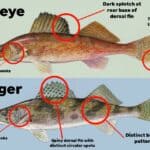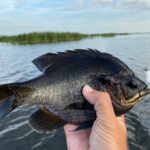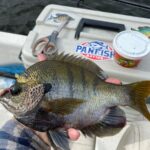If you’ve fished long enough in the freshwater lakes and ponds of the United States, you’ve likely heard the term ‘Coppernose Bluegill‘.
Tales from the old-timers claiming buckets full of “1 pound copper nose“.
But, what is a copper nose bluegill? Is it a hybrid or a natural species? How do you catch them, or where can I find them for my own pond or lake?
In this article, I’m going to tell ya everything you need to know!
Table of Contents
What is a Coppernose Bluegill?
The Coppernose Bluegill (Lepomis machrochirus purpurescens) is a subspecies of the common northern bluegill. Coppernose are native to Florida and found in the southeast United States.
The Coppernose bluegill is not a hybrid species, it occurs naturally in the wild and is common in lakes, ponds and rivers where it shares habitat with other freshwater fish species.
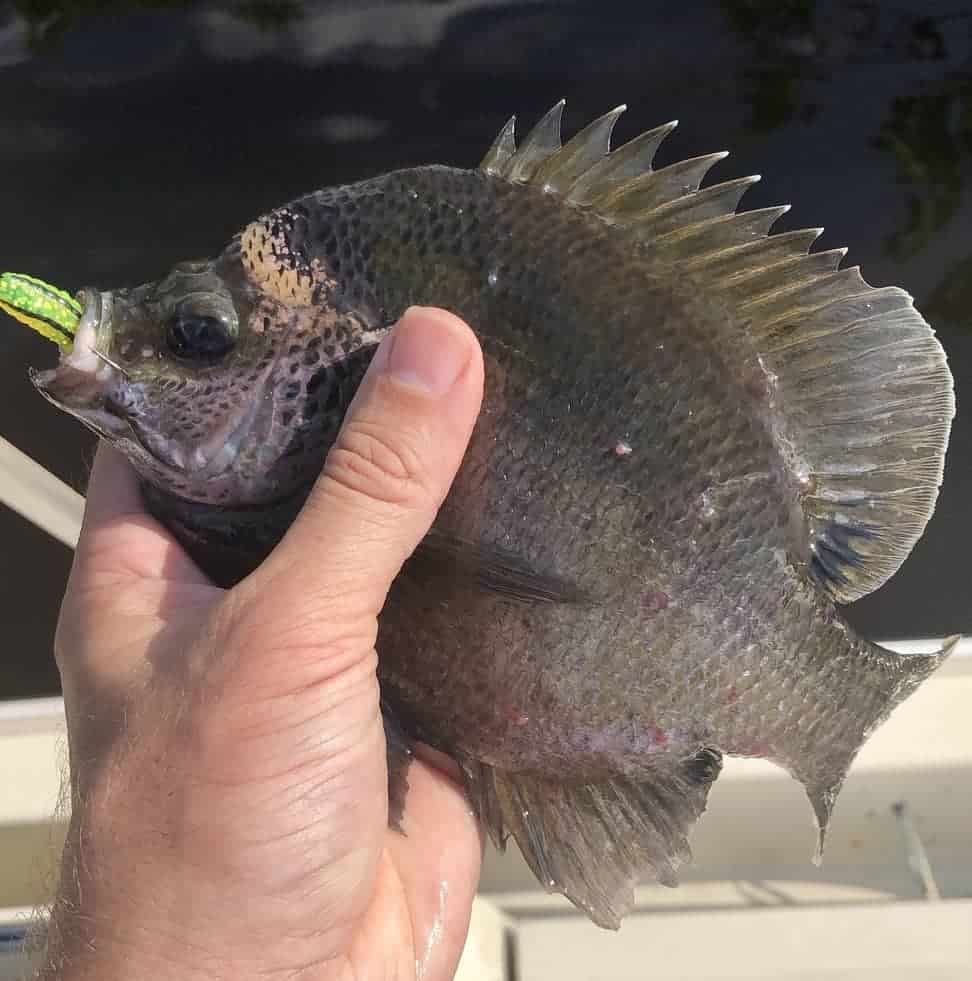
Due to its reputation for fast growth rates, it’s also very popular in the aquaculture community as a stocked sportfish. More on that later.
Coppernose Bluegill Growth Rates
Part of the legend and lore behind the Coppernose Bluegill is that they grow faster and larger than their northern counterparts. This is partially true.
During the early stages of life, from fish fry stage to juvenile (2-3 inches) the Coppernose Bluegill does grow quicker than the Northern Bluegill.
However, after it reaches the pre-adult stages that growth rate begins to taper off and there is not a discernible difference in growth.
While both coppernose and northern bluegill can reach sizes in excess of 1 pound, research has shown that coppernose only grow faster than northern bluegill during the first few months of life. This short lived growth advantage allows more coppernose to survive their first summer and reach intermediate sizes (3 to 4 inches) which are preferred by large bass. However, coppernose are less cold tolerant than northern bluegill and experience has shown mortality under ice cover in northern climates.
-J.M. Malone and Son, Inc. https://www.jmmaloneandson.com/
More importantly, the health and available feed plays a much bigger role in the growth rates and size potential of the coppernose.
In other words, you can stock a pond full of coppernose bluegill, but if you do not have sufficient nutrients, feed and predator balance they will never reach their full size potential.
Coppernose Bluegill Description
The Coppernose Bluegill has a copper or vanilla-colored pattern on the nose (between the eyes and forehead) that gives way to its unique name.
The species is also characterized by the darker coloration of purple and black patterns, especially in spawning males.
The Coppernose Bluegill shares the same traditional ‘panfish’ body shape as the common northern bluegill.
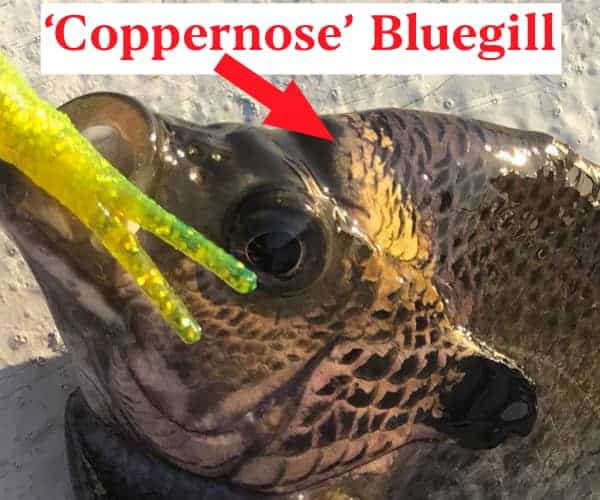
However, the vertical bars are usually more distinct on a Coppernose, and the fins may have yellow or cream-colored edges. Both species have the distinct dark ‘ear flap’ on the operculum.
Coppernose Bluegill Scientific Name
Lepomis machrochirus purpurescens.
What do Coppernose Bluegill Eat?
Coppernose Bluegill are primarily insectivores and eat the same as regular bluegill.
They feed on aquatic vegetation at different times during their life cycle. Common food sources include zooplankton, insect larvae, crustaceans, and small baitfish.
What is a Copper Nose Bream?
A copper nose bream is the same thing as a Coppernose Bluegill. The term ‘bream‘ is often interchanged by anglers when referring to a panfish or sunfish.
Related: What Is the Difference Between Bream and Crappie?
How Do You Catch Coppernose Bluegill?
Fishing for Coppernose Bluegill is the same as fishing for the common northern Bluegill.
Use ultralight tackle, small wire hooks, and fish in shallow water (6 feet or less).
Popular artificial lures for Coppernose Bluegill include Johnson Beetlespin, Mepps in-line spinners, rooster tails and small topwater poppers.
If you want to try bait, Coppernose cannot resist a live cricket or nightcrawler on a #8 wire hook under a small cork.
The best Coppernose Bluegill fishing is during the summer months when Bluegill are spawning.
This means very active fish that are aggressive and plentiful!
Stocking Coppernose Bluegill
Coppernose Bluegill are a very popular species to stock in small lakes and ponds due to their early growth rates and ability to thrive in warm water environments.
That being said, always consult with a fisheries biologist before stocking.
Coppernose are native to Florida, and therefore do not do well in cold water climates. The farthest north I have heard of them being stocked is around Tennessee.
They do very well in states with mild winters.
The price of Coppernose Bluegill varies but usually ranges between .50 centers and $1 per fish depending on the size and demand.
Consider using an automatic fish feeder to get your stocked bluegill on a regular feed schedule.
This will really boost their growth potential and make them great fun to catch for the whole family.
Where to buy Coppernose Bluegill
http://www.dunnsfishfarm.com/ (Arkansas, Oklahoma)
https://southlandfisheries.com/ (South Carolina, North Carolina)
https://pondking.com/ (Texas)
https://trophypond.com/ (Tennessee, Alabama, Georgia, Kentucky)
https://www.southernstateshatchery.com/ (Alabama, Georgia, Mississippi, Louisiana)
https://www.jmmaloneandson.com/ (Arkansas, Oklahoma, Louisiana, Mississippi)
Hybrid Coppernose Bluegill
Hybrid Bluegill, sometimes referred to as Hybrid Coppernose Bluegill are popular choices when stocking fishing ponds.
However, the Coppernose bluegill is not a hybrid. The coppernose is a distinct sub-species that occurs naturally in the wild.
Hybrid Bluegill sold by fish farms are a deliberate cross between a male northern bluegill and female green sunfish.
Final Thoughts
The Coppernose Bluegill is a beautiful fish in its own right and a desirable gamefish for anglers and small pond owners.
I personally love that shiny copper color along with the dark purple bars that make these fish so unique.
Biologically speaking, they are very similar to common northern bluegill and they share much of the same habitat.
Next time you’re out on the lake, pay close attention while fishing for bluegills…
Maybe you’ve caught a copper nose and didn’t even realize it?
Thanks for reading…now get outside and go fishing!
You May Also Like: Why Does My Pond Only Have Small Bass? Here’s Why!
If you haven’t guessed yet, I love fishing and everything about it!
To learn more about why I started Panfish Nation, visit the About page and follow along on Social Media:


Download a copy of my FREE Lure Color Selection Chart & Knot Guide!
Stay up to date with fishing reports, tackle reviews, industry news, and much more! We respect your privacy, unsubscribe at any time.
Like this post? Save it on Pinterest.

Related Posts
- Sauger vs Walleye: Learn These Differences and Catch More!
- Crazy Facts About the World Record Crappie
- What Size Hooks for Smallmouth Bass? Quick Guide
- Large and in Charge-Mouth: 10 of the Best Bass Lures of All Time (And Where to Buy Them)
- Emperor of the Sun(fish): What You Need to Know About the World Record Bluegill
- Coppernose Bluegills: How They’re Different from Common Bluegill

